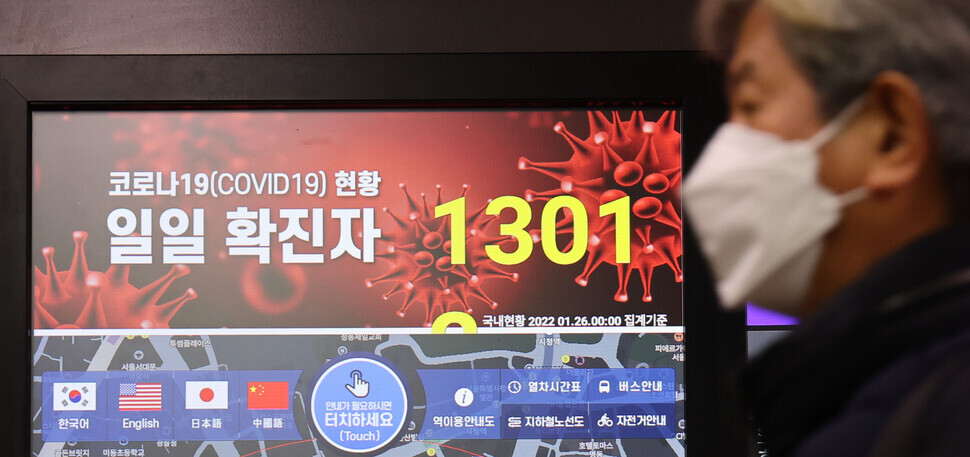hankyoreh
Links to other country sites 다른 나라 사이트 링크
S. Korea’s COVID-19 response put to the test with skyrocketing cases

South Korea came close to 15,000 COVID-19 cases in a single day on Wednesday, with figures expected only to rise in the coming days due to the rapid spread of the Omicron variant. Meanwhile, the South Korean government plans to expand its Omicron response system nationwide on Saturday, but preparations are still needed to prevent the collapse of not just patient management, but other essential social services like healthcare and education.
According to the Korea Disease Control and Prevention Agency (KDCA), South Korea reported 14,518 new confirmed cases of the COVID-19 virus as of the end of the day Wednesday, breaking the previous day’s record of 13,012 cases.
Authorities anticipate this upward trend to continue, with daily caseloads projected to reach a maximum of 120,000 in February. Based on the agency’s mathematically modeled analysis of short-term COVID-19 forecasts published Friday, daily caseloads are projected to reach the 15,000-21,000 range by mid-February and 32,000 to 52,000 by late February, assuming Omicron spreads 2.5 times faster than the Delta variant. If Omicron is three times more transmissible than Delta, daily caseloads may reach 27,000 to 37,000 by mid-February and 80,000 to 120,000 by late next month.
In the meantime, in addition to its plans to expand its Omicron response system, the South Korean government is in the process of developing a “one-stop at-home treatment model” with the Korean Medical Association and other medical groups — a plan for which it is currently recruiting local hospitals and clinics to participate in COVID-19 treatment.
Once initiated, the model will allow local hospitals and clinics to take charge of all aspects of COVID-19 care, from test administration, medical examination and treatment, to at-home treatment monitoring. Currently, designated respiratory clinics are responsible for COVID-19 diagnosis and treatment, but the change will allow neighborhood clinics to administer diagnostic tests and monitor at-home treatment.
The spike in daily caseloads has also raised concerns about the urgent need to prepare for the potential collapse of basic social functions. For example, many are calling for measures to prevent a breakdown of the healthcare system due to mass infection amongst healthcare professionals or the failure of other essential services like childcare, education, public safety and fire protection.
The South Korean government is in the process of developing a plan to maintain operation during periods of high caseloads for each of its ministries. KDCA official Koh Jae-young said, “We requested government ministries to each come up with a list of key services it provides that are necessary for the maintenance of essential social services and to develop a plan for the maintenance of such services.”
He continued, “For example, we suggested that they plan for emergencies by determining how to configure emergency organizations in areas such as childcare, education, and public safety, identifying key services and their priority, and activating remote work schemes. We also asked that they institute workplace disease prevention measures within a set time frame.”
Kim Dong-hyun, professor of social medicine at Hallym University’s College of Medicine, noted, “Contingency plans should be made for different caseload levels depending on different disease prevention conditions. Each scenario for 30,000, 50,000, and 100,000 daily caseloads requires a different plan.”
Some are specifically urging for a contingency plan in case it becomes difficult for community health centers and hospitals to stay open due to healthcare workers contracting COVID-19.
Kim Yoon, professor of health policy and management at Seoul National University College of Medicine, said, “While medical professionals should isolate according to protocol [when infected with COVID-19], the isolation requirement should be applied flexibly when infections are widespread among [medical professionals] — for example, asymptomatic healthcare workers who have undergone a minimum period of isolation may be allowed to come back to work a little early.”
By Park Jun-yong, Jang Hyeon-eun and Lim Jae-hee; staff reporters
Please direct questions or comments to [english@hani.co.kr]

Editorial・opinion
![[Column] Welcome to the president’s pity party [Column] Welcome to the president’s pity party](https://flexible.img.hani.co.kr/flexible/normal/500/300/imgdb/original/2024/0515/3917157400447943.jpg) [Column] Welcome to the president’s pity party
[Column] Welcome to the president’s pity party![[Editorial] Korea must respond firmly to Japan’s attempt to usurp Line [Editorial] Korea must respond firmly to Japan’s attempt to usurp Line](https://flexible.img.hani.co.kr/flexible/normal/500/300/imgdb/original/2024/0514/2317156736305813.jpg) [Editorial] Korea must respond firmly to Japan’s attempt to usurp Line
[Editorial] Korea must respond firmly to Japan’s attempt to usurp Line- [Editorial] Transfers of prosecutors investigating Korea’s first lady send chilling message
- [Column] Will Seoul’s ties with Moscow really recover on their own?
- [Column] Samsung’s ‘lost decade’ and Lee Jae-yong’s mismatched chopsticks
- [Correspondent’s column] The real reason the US is worried about Chinese ‘overcapacity’
- [Editorial] Yoon’s gesture at communication only highlights his reluctance to change
- [Editorial] Perilous stakes of Trump’s rhetoric around US troop pullout from Korea
- [Guest essay] Preventing Korean Peninsula from becoming front line of new cold war
- [Column] The state is back — but is it in business?
Most viewed articles
- 1[Editorial] Korea must respond firmly to Japan’s attempt to usurp Line
- 2[Editorial] Transfers of prosecutors investigating Korea’s first lady send chilling message
- 3[Column] Welcome to the president’s pity party
- 4Second suspect nabbed for gruesome murder of Korean in Thailand, 1 remains at large
- 5Could Korea’s Naver lose control of Line to Japan?
- 6Major personnel shuffle reassigns prosecutors leading investigations into Korea’s first lady
- 7Naver’s union calls for action from government over possible Japanese buyout of Line
- 8Unexpected rate of AI development requires timely discussion of side effects
- 9US has always pulled troops from Korea unilaterally — is Yoon prepared for it to happen again?
- 10China gains 2 new ambassadors to Korea in form of newborn panda cubs